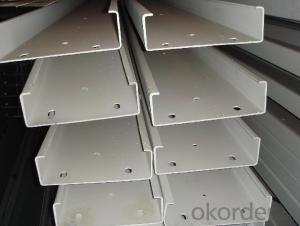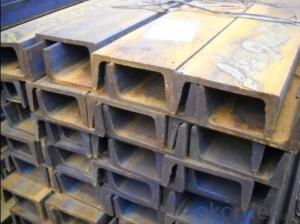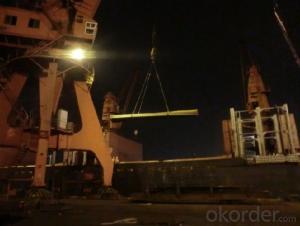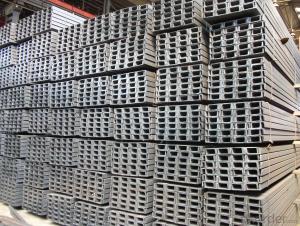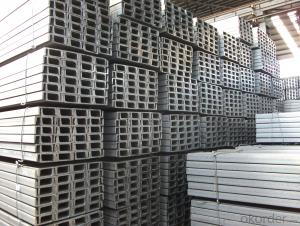channel
- Loading Port:
- China Main Port
- Payment Terms:
- TT OR LC
- Min Order Qty:
- -
- Supply Capability:
- -
OKorder Service Pledge
OKorder Financial Service
You Might Also Like
Product Description:
Specifications of MS Channel:
1.We supply high quality MS Channel at reasonable price, including Chinese standard, Japanese standard and so on.
Standard | GB/JIS |
Material Grade | Q235,SS400 |
Technique: | Hot Rolled |
Sizes as per chinese standard: | 50*37*4.5mm - 300*89*11.5mm |
Sizes as per japanese standard: | 50*25*3mm – 200*80*7.5mm |
Length: | 6meter, 9meter, 12meter |
Note: 1.we are also competent to provide our customers other MS Channel based on other sizes according to customer’s requirements.
2. The length of our ms channel could be cut into other meters as per customer’s requirements. For example, the channel in 6meters could be cut into 5.8meters in order to be fit in the 20ft container.
2. The detailed sections of MS Channel as per GB standard.are shown in the table-1:
GB U CHANNEL | Standard | Sectional | Dimension |
| Mass: |
| (mm) | (mm) | (mm) | (mm) |
|
50X37 | 50 | 37 | 4.50 | 7.0 | 5.438 |
63X40 | 63 | 40 | 4.80 | 7.5 | 6.634 |
80x43 | 80 | 43 | 5.00 | 8.0 | 8.045 |
|
|
|
|
|
|
100x48 | 100 | 48 | 5.30 | 8.5 | 10.007 |
120x53 | 120 | 53 | 5.50 | 9.0 | 12.059 |
140x58 | 140 | 58 | 6.00 | 9.5 | 14.535 |
140x60 | 140 | 60 | 8.00 | 9.5 | 16.733 |
|
|
|
|
|
|
160x63 | 160 | 63 | 6.50 | 10.0 | 17.240 |
160x65 | 160 | 65 | 8.50 | 10.0 | 19.752 |
|
|
|
|
|
|
180x68 | 180 | 68 | 7.00 | 10.5 | 20.174 |
180x70 | 180 | 70 | 9.00 | 10.5 | 23.000 |
|
|
|
|
|
|
200x73 | 200 | 73 | 7.00 | 11.0 | 22.637 |
200x75 | 200 | 75 | 9.00 | 11.0 | 25.777 |
|
|
|
|
|
|
220x77 | 220 | 77 | 7.00 | 11.5 | 24.999 |
220x79 | 220 | 79 | 9.00 | 11.5 | 28.453 |
|
|
|
|
|
|
250x78 | 250 | 78 | 7.00 | 12.0 | 27.410 |
250x80 | 250 | 80 | 9.00 | 12.0 | 31.335 |
250x82 | 250 | 82 | 11.00 | 12.0 | 35.260 |
|
|
|
|
| |
280x82 | 280 | 82 | 7.50 | 12.5 | 31.427 |
280x84 | 280 | 84 | 9.50 | 12.5 | 35.823 |
280x86 | 280 | 86 | 11.50 | 12.5 | 40.219 |
|
|
|
|
|
|
300x85 | 300 | 85 | 7.50 | 13.5 | 34.463 |
300x87 | 300 | 87 | 9.50 | 13.5 | 39.173 |
300x89 | 300 | 89 | 11.50 | 13.5 | 43.883 |
Table-1
3. The chemical composition of HR Channel Steel according to Q235B is shown in Table-2.
Alloy No | Grade | Element(%) | ||||
C | Mn | S | P | Si | ||
Q235 | B | 0.12-0.20 | 0.3-0.7 | ≦0.045 | ≦0.045 | ≦0.3 |
Table-2
Note: we are able to present our customers relevant SGS test report for chemical composition of HR Channel Steel.
4. The mechanical property of HR Channel Steel according to Q235B is shown in Table-3-1 and Table-3-2
Alloy No | Grade | Yielding Strength Point(Mpa) | |||
Thickness(mm) | |||||
≦16 | >16-40 | >40-60 | >60-100 | ||
≧ | |||||
Q235 | B | 235 | 225 | 215 | 205 |
Table-3-1
Alloy No | Grade | Tensile Strength(Mpa) | Elongation After Fracture(%) | |||
Thickness(mm) | ||||||
≦16 | >16-40 | >40-60 | >60-100 | |||
≧ | ||||||
G235 | B | 375-500 | 26 | 25 | 24 | 23 |
Table-3-2
Note: we are able to present our customers relevant SGS test report for mechanical property of MS Channel as customer’s request.
Applications of MS Channel:
The MS Channel can be applied to construction of warehouses, workshops, sport stadiums and car parks etc.The hot rolled channel steel belongs to carbon structural steel which is applied to in the field of construction and machinery.In details, the hot rolled channel steel is usually used for arch-itechtural structure, and they could be welded in order to support or hang a vari-ety of facilities. They are also usually used in combination with I beam. Generally,the hot rolled channel steel we supply must possess perfect welding property, riveting property and mechanical property and so on.
Package & Delivery of MS Channel:
1.The hot rolled channel steel will be packed in bundle with steel wire at each end of every bundle and color marking in order to help the customer to recognize his goods more easily at sight.
2. And the hot rolled channel steel could be loaded into 20ft or 40ft container, or by bulk cargo.If the weight of each bundle reaches more than 3.5 mt, the loading by break bulk cargo should be choosed.When the weight of each bundle reaches less than 3mt, the loading by container should be choosed.
3.As for the transportaion from mill to loading port, the truck will be usually used. And the maximum quantity for each truck is 40mt.
4.All in all, we could do in accordance with customer's request
- Q: How do steel channels contribute to the overall safety of a structure during floods?
- Steel channels contribute to the overall safety of a structure during floods in several ways. First and foremost, steel channels provide structural support and reinforcement to the building, making it more resistant to the forces and pressure exerted by floodwaters. These channels are designed to withstand high loads and distribute the weight evenly, ensuring the stability and integrity of the structure even in extreme flood conditions. Additionally, steel channels can be strategically placed in flood-prone areas to redirect the flow of water away from critical areas of the building. By creating barriers or channels, they help to control and manage the water flow, preventing it from entering vulnerable spaces or causing damage to the foundation. This redirection of water minimizes the risk of structural failure or collapse during floods. Moreover, steel channels are highly resistant to corrosion, which is crucial in flood-prone areas where water exposure is frequent. By using corrosion-resistant steel channels, the risk of deterioration and weakening of the structure due to prolonged exposure to water is significantly reduced. Furthermore, steel channels can be utilized to create flood-resistant doors and barriers. These doors are designed to withstand the water pressure and prevent its entry into the building. This is particularly important in critical areas such as basements or lower levels, where water infiltration can cause extensive damage to utilities or compromise the overall stability of the structure. In summary, steel channels contribute to the overall safety of a structure during floods by providing structural support, redirecting water flow, resisting corrosion, and creating flood-resistant barriers. By incorporating these features into the design and construction of a building, the risk of damage and destruction during floods can be significantly mitigated, ensuring the safety of occupants and preserving the integrity of the structure.
- Q: What are the different methods of cutting steel channels?
- There are various ways to cut steel channels, depending on specific needs and available tools. Here are some commonly used methods: 1. For smaller projects or when only a few cuts are necessary, manual cutting is suitable. This method involves using hand tools like hacksaws, bolt cutters, or shears. 2. Plasma cutting is a fast and precise technique that utilizes a high-velocity jet of ionized gas (plasma) to cut through steel channels. It can be used for both straight and curved cuts, often employing a CNC plasma cutting machine for larger projects. 3. Laser cutting is an efficient method that employs a high-powered laser beam to melt or vaporize the steel channels, resulting in a precise cut. It is commonly used in industrial applications and is suitable for both thick and thin steel channels, producing clean edges. 4. Waterjet cutting is a versatile technique that involves a high-pressure stream of water mixed with abrasive particles to cut through various materials, including steel. It is known for its accuracy and ability to create complex shapes. 5. Saw cutting, a traditional approach, uses a circular saw or band saw with a metal-cutting blade. It is suitable for straight cuts and can handle both thin and thick steel channels. 6. Oxy-fuel cutting is primarily used for cutting thicker steel channels in heavy industrial applications. It involves heating the steel channels to their ignition point using a mixture of fuel gas and oxygen, then introducing a high-pressure stream of oxygen to create the cut. When choosing a cutting method for steel channels, it is crucial to consider factors such as required precision, speed, and budget.
- Q: Channel 10 is calculated, if the price per metre is calculated
- On the market, the sale of 10 channel steel, a lot less than the national standard weight, the general negative difference in 5% within the standard. Depending on your use requirements, the maximum negative difference may be as high as 30%.
- Q: How do steel channels contribute to sound insulation?
- Steel channels can contribute to sound insulation by creating a barrier between the source of the sound and the surrounding environment. The use of steel channels helps to absorb and dampen sound vibrations, reducing the transmission of noise through walls and ceilings. Additionally, the rigid structure of steel channels helps to prevent the resonance and amplification of sound waves, further enhancing sound insulation.
- Q: I unit of a shopping center construction project, 4.2 meters high, four floors.Because the first floor is adjacent to the building, the scaffold can not be erectedWe would like to use 20 channel three from 2 to 15 meters, ask how much channel spacing?
- You set the bar spacing 1.5 meters, step distance 1.8, the general parameters know the spacing of the channel.
- Q: What are the different surface finishes available for painted steel channels?
- Some of the different surface finishes available for painted steel channels include smooth, matte, satin, and high gloss finishes. These finishes can be achieved through various techniques such as sandblasting, powder coating, or using different types of paints or coatings. The choice of surface finish depends on the desired aesthetic appearance and the level of durability or resistance required for the specific application.
- Q: How do steel channels contribute to indoor air quality?
- Steel channels do not directly contribute to indoor air quality as they are primarily used for structural purposes in construction. However, their use in building construction can indirectly contribute to a healthier indoor environment by providing a sturdy framework that supports proper ventilation systems, which play a crucial role in maintaining good air quality.
- Q: Can steel channels be used in the construction of mezzanine floors?
- Yes, steel channels can be used in the construction of mezzanine floors. Steel channels are commonly used in construction for their strength and durability. Mezzanine floors are typically added to existing buildings to create additional space and are often used in industrial and commercial settings. Steel channels provide structural support and can be used as beams or joists in mezzanine floor construction. They are able to withstand heavy loads and provide a stable and secure platform for various purposes, such as storage, offices, or additional workspace. Additionally, steel channels can be customized to meet specific design and structural requirements, making them a versatile choice for mezzanine floor construction.
- Q: Six meters long, standard 10 channel steel, theoretical weight
- The finished channel steel is delivered by hot forming, normalizing or hot rolling. The specifications are expressed in millimeters of height (H) * leg width (b) * waist thickness (d), such as 100*48*5.3, which means waist height is 100 mm, leg width is 48 mm, waist thickness is 5.3 mm channel, or 10# channel steel. The same height of the channel, if there are several different leg width and waist thickness, also need to add a, B, C on the right side of the model to distinguish, such as 25#a, 25#b, 25#c and so on.
- Q: What are the different welding techniques used for steel channels?
- There are several different welding techniques used for steel channels, each with its own advantages and considerations. 1. Shielded Metal Arc Welding (SMAW): Also known as stick welding, SMAW is a commonly used technique for welding steel channels. It involves the use of a consumable electrode coated in flux, which creates a shield around the weld pool to protect it from atmospheric contamination. SMAW is versatile and can be used in various positions, making it suitable for welding steel channels of different sizes and thicknesses. 2. Gas Metal Arc Welding (GMAW): GMAW, also known as MIG (Metal Inert Gas) welding, is another popular technique used for steel channel welding. It uses a wire electrode that feeds through a welding gun, along with a shielding gas, usually argon or a mixture of argon and carbon dioxide. GMAW provides high welding speeds and allows for continuous welding, making it efficient for welding long steel channels. 3. Flux-Cored Arc Welding (FCAW): FCAW is similar to GMAW, but instead of using a solid wire electrode, it uses a tubular flux-cored wire. This wire contains a flux material that provides the shielding gas and helps to create a slag that protects the weld pool. FCAW is often preferred for outdoor applications or in situations where the welds may be exposed to wind or drafts. 4. Submerged Arc Welding (SAW): SAW is a technique that involves the use of a continuously fed electrode and a granular flux that covers the weld pool entirely. The arc is submerged under the flux, hence the name. SAW is commonly used for welding thick steel channels or when high deposition rates are required. It provides excellent penetration and produces high-quality welds with minimal spatter. 5. Tungsten Inert Gas Welding (TIG): TIG welding, also known as Gas Tungsten Arc Welding (GTAW), is a technique that uses a non-consumable tungsten electrode and a shielding gas, usually argon. TIG welding is known for its precision and ability to produce high-quality welds. It is often used for welding thin steel channels or when aesthetic appeal is important, as it provides excellent control over the heat input and produces precise and clean welds. It is important to note that the choice of welding technique for steel channels depends on various factors such as the thickness of the channels, the desired weld quality, the available equipment, and the specific application requirements.
Send your message to us
channel
- Loading Port:
- China Main Port
- Payment Terms:
- TT OR LC
- Min Order Qty:
- -
- Supply Capability:
- -
OKorder Service Pledge
OKorder Financial Service
Similar products
Hot products
Hot Searches
Related keywords











